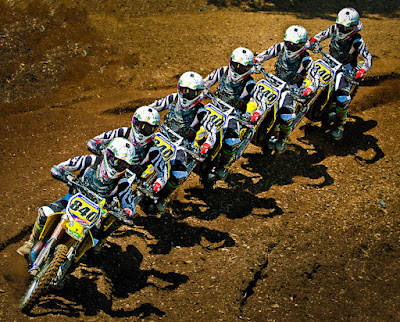 Today's image, obviously, is a series a images taken using
continuous high speed shutter. Before we
get into it I'll talk a little bit about Nikon's (or any manufacturer's)
continuous mode of shooting. It kind of
cracks me up when some friends say with certainty that their camera can shoot
at six, seven or nine frames per second.
In the case of today's image(s) that's most likely the case. But, if you're in low light and your shutter
speed is one second, you can shoot at a maximum of --- one frame per second. If you're shooting a seven shot bracket, and
your "normal" shutter speed is 1/100 of a second, you'd have 1/12 of
a second as your longest shutter speed.
Add up 1/12th +1/25th +1/50th +1/100th + 1/200, +1/400, and 1/800th and
you'll find you've used up just about that whole second. Start at 1/50th and that one second is long
gone before you get that six frames per second over. A friend of mine who has a D3 (not a D3X)
found that out the hard way when he heard my D300 start to labor during a seven
shot bracket. He wanted to show me how
fast his D3 was. I told him to use the
same Aperture I had, in Aperture Priority Mode.
His camera went click, click. click, click, click,
click, click, same as mine
had. There are some rules of physics
that you can't break no matter how good your camera is. But, back at today's image, it's a burst of
exposures in high speed continuous mode with plenty of sunlight. It was clicking away as fast as the mechanism
would go. Seeing as the Nikon D300 can
run at six frames per second, today's image should be about a one second
interval. Putting the sequence together
in Adobe Photoshop CS5 is easier than you might suspect. To learn how it was done, hit the "Read
More".
Today's image, obviously, is a series a images taken using
continuous high speed shutter. Before we
get into it I'll talk a little bit about Nikon's (or any manufacturer's)
continuous mode of shooting. It kind of
cracks me up when some friends say with certainty that their camera can shoot
at six, seven or nine frames per second.
In the case of today's image(s) that's most likely the case. But, if you're in low light and your shutter
speed is one second, you can shoot at a maximum of --- one frame per second. If you're shooting a seven shot bracket, and
your "normal" shutter speed is 1/100 of a second, you'd have 1/12 of
a second as your longest shutter speed.
Add up 1/12th +1/25th +1/50th +1/100th + 1/200, +1/400, and 1/800th and
you'll find you've used up just about that whole second. Start at 1/50th and that one second is long
gone before you get that six frames per second over. A friend of mine who has a D3 (not a D3X)
found that out the hard way when he heard my D300 start to labor during a seven
shot bracket. He wanted to show me how
fast his D3 was. I told him to use the
same Aperture I had, in Aperture Priority Mode.
His camera went click, click. click, click, click,
click, click, same as mine
had. There are some rules of physics
that you can't break no matter how good your camera is. But, back at today's image, it's a burst of
exposures in high speed continuous mode with plenty of sunlight. It was clicking away as fast as the mechanism
would go. Seeing as the Nikon D300 can
run at six frames per second, today's image should be about a one second
interval. Putting the sequence together
in Adobe Photoshop CS5 is easier than you might suspect. To learn how it was done, hit the "Read
More".
The first thing to do was to bring the six frames into CS5
from Adobe Photoshop Lightroom 3 as stacked Layers (Photo/Edit In/Open As
Layers In Photoshop). This will save the
hassle of opening each image and doing any sort of Copy and Paste to get all
the images into one document. They will
go into CS5 in the order they were taken.
From back to front (from lowest number in the sequence to the highest
number). That puts the rear image on the
top of the Layer Stack. Just the opposite
way we'd need them. So, the first thing
(in CS5) that needs to be done is to rearrange the order so that the closet
image is at the top of the stack and the stack descends back to the furthest
image being on the bottom.
Because I was panning as a followed the rider the edges of
the shots don't lineup. They look a
little like a stair step sequence going from low at the left to high at the
right. We'll fix that later. To figure out where the alignment falls we
need to pairs, starting at the two bottom Layers and turning off all the
others. To get into the general area I
lowered the Opacity of the upper Layer to about 50%. The ruts above the rider remained in one
place. I used that as a key and moved
the upper image up to match ruts. One I
got it close I brought the Opacity back up to 100% and changed the Blend Mode
to Difference. With the Move Tool (V)
selected I used the left, right, up and down cursor control keys to nudge the
Layer until the area over the ruts went back.
To check I went one click further in each direction to confirm the
placement.
The next step was to make a Layer Mask. Using the Quick Selection Tool (W) the target
cursor was pulled down through the rider on the lowest Layer. Once the selection was cleaned up I right
clicked inside the selection. This
brought up a dialog box and Save Selection was clicked. This produces an Alpha Channel. If you are using Adobe Photoshop Elements 9
you can go to Select/Save Selection and you too will have an Alpha
Channel. It's the way selections are
saved, if Adobe lets you see the Channels or not. This process was repeated up through the
entire set of Layers.
From there, each Layer was given a Layer Mask based on the
Selection that had been made for that particular Layer. This showed each iteration of the rider. Each Mask was then painted with Black using
the Brush Tool (B) beneath the rider, revealing the rider's shadow. This is actually the trickier part of the
masking.
One thing that happened was that the top of the lower left
was lower than the head of the rider in the third frame. Therefore the canvas had to be expanded. Rather than going to the dialog box
(Image/Canvas Size), an easier method (when the dimensions are unknown) is to
use the Crop Tool (C). With the entire
visible image selected, grab the upper middle "handle" and pull up
out of the image rather than down into the image. As soon as the mouse click is lifted
additional canvas is added and the rest of the image revealed. I had to do this twice as I was building
today's image. The second time I had to
go up and to the right. I just grabbed
the handle in the upper right corner and pulled.
The "stair step" was handled using Content Aware
Fill. The first try resulted in riders
heads in the lower right corner. A Layer
Mask was put on the image masking out the riders. That gave a better result, but not great. The next attempt was taking small chunks and
doing CAF to about a half dozen pieces to make it look right.
The image was brought back
into LR3 and tones, brightness, colors, sharpness, clarity, etc brought up
there. The upper left and lower right
were darkened to put the emphasis on the riders to complete the scene.





0 comments:
Post a Comment